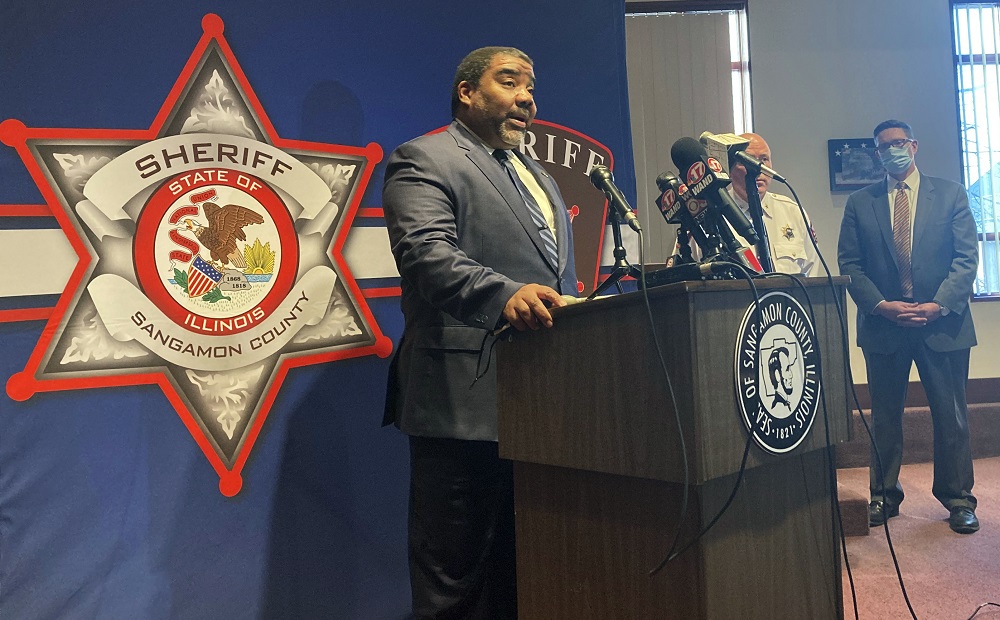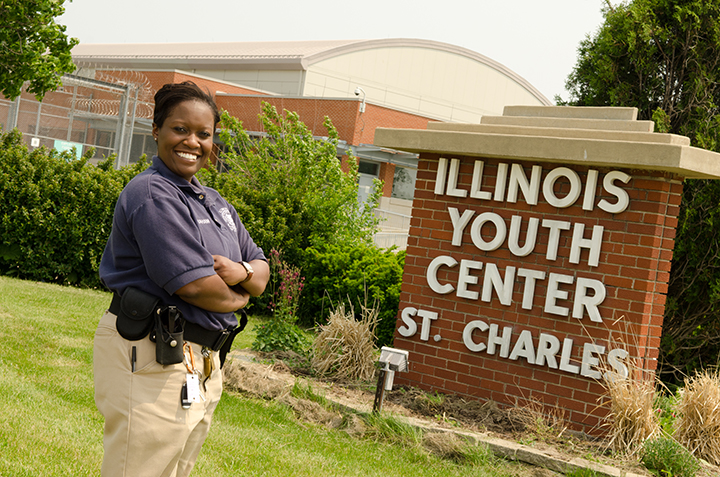CHICAGO — The day Deidre Silas was murdered, the social worker went alone on a house call after receiving a report that kids might be living in unsanitary conditions.
The Illinois Department of Children and Family Services office in Springfield, Illinois, where she worked didn’t expect the visit on Jan. 4, 2022, to be any trouble. The department encourages social workers to call for a police escort in situations they anticipate to be volatile, but the family had no known history of violence.
When Silas arrived at the home, about a half hour’s drive south of Springfield in Thayer, a town of fewer than 700 people, she discovered more people, including children, living in the home than she knew before she got into her car that afternoon. In total, six adults and five children were crammed together in a two-bedroom, 900-square foot home filled with rotting garbage and animal feces, according to law enforcement. Silas’ job as an investigator was to ensure the safety of the children. So when she found additional kids, she insisted on adding them to the welfare check.
While trying to persuade their mother to allow her to check on them, a man related to one or more of those children allegedly stabbed Silas to death.
Silas’ death set off a wave of calls for safety reforms from the union of Illinois public employees as well as lawmakers and child welfare organizations.
A year later, state officials charged with overseeing child welfare investigations point to big changes they have in the works that they argue will make child welfare workers safer.
But child welfare investigators, advocates, watchdogs and others who work in the field say little has actually changed. They say the root cause that sent Silas out alone — too few caseworkers and too many cases — has persisted in the state for years despite a 1988 federal consent decree that was supposed to limit the number of new cases given to investigators.
By any metric, “DCFS is the worst it’s been in decades — empirically so,” said Charles Golbert, the Cook County public guardian and an outspoken critic of the department. Golbert’s office provides legal representation for abused and neglected children, children in custody and divorce cases, and some people with disabilities.
“When caseloads are 50 percent higher than they’re supposed to be, you don’t have time to think things through,” Golbert said. “It just makes for a very dangerous brew for the investigators in the field doing this work.”
Silas was the second Illinois child protective services investigator to be killed in the line of duty in less than five years. In 2017, an investigator named Pamela Knight was badly beaten during a home visit.
She died months later from injuries sustained during the assault. The department is still working to implement changes called for after Knight’s death more than five years later.
Who was Deidre Silas?
Silas, 36, had been with the child welfare department for less than a year when she was killed. Before that, she worked at the Department of Juvenile Justice for more than seven years, first as a corrections officer and then as a union steward.
“When caseloads are 50 percent higher than they’re supposed to be, you don’t have time to think things through. It just makes for a very dangerous brew for the investigators in the field doing this work.”
She was survived by her mother, Barie Graham; her father, Roy Graham; her brother, Mario Graham; her husband, Andre Silas; and her two young children, according to local news reports.
Attempts to reach Silas’ family for comment by phone, social media and through the prosecutor’s office were unsuccessful. Speaking with ABC 20 news channel shortly after her death, family members described her as caring, dedicated to her job and often willing to go the extra mile to help others.
“No matter how hard it was for her, Deidre always did the right thing,” her husband, Andre Silas, said.
Andre Silas told the station he hoped his wife’s death would spark changes at the department where she worked and prevent similar deaths in the future.
“There should be preventative measures in place,” he said. “If they can’t use my wife’s example to figure out what they need to do as far as getting that training, getting those protocols in place, then I don’t know what else needs to happen.”
A family friend of the Grahams’ named Brenda also spoke out at Silas’ funeral, urging department leaders who were in attendance to make changes in the department that would prevent future tragedies, local news reported.
Deidre Silas’ brother, Mario Graham, wrote of the pain the family suffered in an online fundraising appeal that raised more than $73,000.
He described his sister as kind, loving and generous, especially toward the children she came across in her work.
“What happened to my sister should have never happened and the world deserves to know and needs answers,” he said.
Benjamin Reed, the man accused of killing Deidre Silas, awaits trial in the Sangamon County Jail in Springfield. He was 32 at the time of his arrest. His defense attorney did not return phone calls. His bond was set at $5 million after being taken into custody last January. He pleaded not guilty, according to court documents.
The Sangamon County prosecutor’s office also did not return phone calls.
A dangerous job
While killings of child welfare social workers remain rare, verbal abuse, threats and violence against them are not. The hostile work environment contributes to high turnover in the field, which in turn leads to understaffing that can exacerbate safety risks, experts say.
A Chicago Tribune investigation found at least a dozen child welfare workers in Illinois were attacked or seriously threatened between 2013 and 2017. Between 2017 and early 2022, 21 suffered physical assaults or violent threats, according to DCFS spokesman Bill McCaffrey.
“It’s a concern, and it’s tragic — it’s horrible when a worker is injured or killed,” said Robin Leake, project director at the National Child Welfare Workforce Institute. “But just the day-to-day stress of being threatened on the job is really hard.”
While Illinois’ child welfare system has its own unique history, it is hardly alone when it comes to threats against child welfare workers.
In a 2020 study, the institute — a consortium of five state universities funded by the U.S. Department of Health and Human Services — found that more than 73% of public child welfare social workers across the U.S. have endured verbal abuse, while more than 36% have been threatened and nearly half have experienced symptoms of post-traumatic stress disorder. The study was based on an analysis of documents, surveys and interviews from four child welfare agencies representative of child welfare agencies nationally.
The same study found annual staff turnover ranges from 21% to 40%, and vacancies often go unfilled for long periods of time.
People who left their jobs reported doing so due to a combination of unrealistic job expectations, unmanageable workloads and the need for work-life balance.
A 2022 study from the Florida Institute of Child Welfare and Florida State University found that nearly all the 1,500 Florida child protective services workers surveyed had experienced some form of violence perpetrated by a client. The study defined violence to include verbal abuse.
The vast majority of new workers encountered this violence within their first six months on the job, the study said.
Melissa Radey, a professor of social work at Florida State University and one of the study’s authors, said some workers reported being pushed or slapped, or having an object thrown at them, but most of the violence was verbal.
“Some of these verbal attacks were quite vicious [and] racially-motivated,” Radey said.
“There’s overwhelmed case managers responsible for all of these kids and their wellbeing, and [the state and companies they contract] don’t really care if you put the case manager in danger as long as they’re doing their job.”
Some workers reported being told they should die — some by lynching. One said she was stalked and threatened on social media by someone who knew where she lived, causing her to live in fear for years.
“I thought, ‘Oh my gosh, could I go to work and imagine facing that every day, or even facing it once?’” Radley recalled.
That kind of stress is typical, said former child welfare social workers and others who spoke to Youth Today. And it’s made worse by chronically understaffed departments, they said.
Two former Florida social workers who spoke with Youth Today on the condition of anonymity because they still work closely with the state child welfare agency in their current jobs said they routinely felt unsafe.
One of the former social workers, who now works as a mental health counselor, said when she was a case manager she received death threats, including from the parent of a former client who threatened to blow up the building where she worked.
“There’s overwhelmed case managers responsible for all of these kids and their wellbeing, and [the state and companies they contract] don’t really care if you put the case manager in danger as long as they’re doing their job,” she said. “It was truly horrible.”
Having too few state social workers is endemic to the field, said Richard Barth, professor and chairman of the Executive Committee of Grand Challenges for Social Work at the University of Maryland.
But some states do a better job than others of making their workers feel valued. Several experts pointed to New York, New Jersey and Vermont as examples.
Management’s attitude at any given office can vary wildly even within the same state and plays an important role in whether people leave or stay, Barth said.
“The culture of the agency matters more than salaries,” he said. Workers like “Feeling heard, feeling like someone has their back.”
Illinois’ troubled child welfare history
Following Silas’ death, the Occupational Safety and Health Administration (OSHA), which oversees workplace safety, recommended that investigators take another employee or law enforcement with them when making first contact with a family, according to documents Youth Today obtained through an open records request.
State officials stressed that Illinois has a longstanding policy allowing child welfare workers to delay a home visit until another staff member or police officer can accompany them on a home visit that could be dangerous.
“They absolutely can and should do that,” said Jassen Strokosch, DCFS chief of staff.
But case workers and others say that is not realistic with their staffing levels and workloads, especially because each case has time requirements for making contact and filing reports. The 1988 consent decree mandates that the department limit case loads to 20 cases per worker, but the state is not in compliance.
Alisha Glover, a child welfare investigator in the Chicago area, said workers in her office are assigned as many as 15-20 new cases each month and typically have an active caseload of 50 at any given time.
“My office has not been fully staffed for [at least] the last three years,” Glover said.
No one has time to go with someone else on their home visit — they barely have time to get their own work done, Glover said. So they go alone, like Silas did. And while those visits usually go as planned, it creates a work environment where investigators often feel unsafe, work under extreme stress and don’t have the time needed for a thorough investigation.
“Even under the best of circumstances, it’s an inherently dangerous job.”
“It’s really difficult to maintain those workloads and get the minimum basic things that have to get done,” Glover said.
Data backs up Glover’s point. According to a 2022 audit from Illinois Auditor General Frank Mautino’s office, DCFS routinely fails to conduct 98% of the items on the state’s checklist meant to ensure a child’s physical safety during investigations.
The department also didn’t have documentation for a majority of cases about whether children received proper care after the department got involved, and children who are taken from their families and end up in the department’s care often don’t receive federally-required health check-ups, the audit said.
All of that can lead to unsafe outcomes for kids and child welfare workers, and it prompts a self-reinforcing cycle of burnout, high turnover and understaffing, experts said.
In the past, Glover said she’s left tense situations and realized only later that things could have gone downhill quickly. Often she responds to an incident following a domestic violence report and doesn’t know if there are weapons in the home, or if the people in the house will be angry when she shows up.
“Even under the best of circumstances, it’s an inherently dangerous job,” said Golbert, the public guardian.
“But if workers are doing that job in a bureaucracy that is utterly inept like DCFS … that’s completely overwhelmed … those risk factors are going to be enhanced.”
Golbert said he understands that the pandemic worsened many longstanding DCFS problems, and that agencies across the country struggle with the same sorts of issues.
But more than 30 years after entering into the federal consent decree, the Illinois Department of Children and Family Services is still struggling to meet its requirements.
Union demands action, but little has changed
After Silas’ death, the union representing her and other Illinois social workers — AFSCME Council 31 — demanded a host of reforms meant to make investigators safer in the line of duty.
The union came up with a list of 26 changes they urged DCFS to make, including providing bullet- and stab-proof shirts, pepper spray training, a “technical fix for areas where state phones don’t get cell reception” and adequate staffing.
The changes called for were similar to those demanded after the death of Knight, the Illinois social worker who died in 2018 from injuries suffered during an attack on the job. She was also conducting a welfare check by herself.
But after five years and two deaths, little has changed on the ground, according to child welfare workers, the union that represents them in Illinois and other experts who work in the child welfare field.
So far, only a handful of investigators have been given stab-proof shirts, although interested staff are now being measured for safety shirts and vests — signaling forward motion to union members, according to a union spokesman. A pilot program for “panic buttons” which investigators can press to alert law enforcement when they’re in danger has launched on a limited basis.
Earlier this year, Illinois Gov. J.B. Pritzker signed a bill into law requiring the department to also give employees pepper spray, despite objections from an array of civil rights and child welfare groups.
A policy on the use of pepper spray was finalized in early January and the department has scheduled four voluntary training sessions on its use for interested employees, union spokesman Anders Lindall said.
But a year after Silas’ death, the department has yet to fully implement most of the safety reforms the union has called for, such as distributing vehicles with enhanced cell phone signal boosters on a broad basis or actually distributing the safety vests and shirts that staff are being measured for.
DCFS also hasn’t yet created a better background check system to offer investigators more information prior to stepping foot in a home or, perhaps most crucially, create a plan to fix the department’s long-standing problem with understaffing, according to Anne Irving, a lobbyist for the union.
“The pace at which it’s happening, that is the frustrating part,” Irving said over the summer.
Short on social workers, state turns to police and pepper spray
DFCS officials said in response to a public records request that they had no records related to any internal investigation into staff safety following Silas’ death. Despite having never produced a formal report, Strokosch, DCFS’ chief of staff, said the agency has taken a “top-to-bottom look” at investigator safety.
He and other department officials pointed to planned changes in employee safety training and also said they are making progress on staffing.
Although DFCS has hired hundreds of new investigators since March 2021, hundreds of veteran investigators switched jobs or retired during the pandemic.
DCFS Director Marc Smith also said the department has made “tremendous progress” on hiring during an interview with Youth Today late last year. But state data shows DFCS in fact has roughly two dozen fewer investigators than it did last spring, department spokesman Bill McCaffrey acknowledged in a follow-up email.
Between June 2021 and Oct. 2022, DCFS lost nearly 500 investigators, McCaffrey said, roughly a 73% turnover in one year. Many veteran child protective workers left during the pandemic, which the department replaced mostly with new recruits. DCFS still has a roughly 21% rolling vacancy rate for investigators.
At the same time, caseloads have skyrocketed following cuts in support services for vulnerable families. In 2017, DCFS conducted about 75,000 investigations. By 2022, that number climbed to more than 97,000, and the department is projecting close to 100,000 in 2023, according to the department’s last budget proposal.
So police are being called on to fill the gap in the meantime.
DCFS Director Smith touted a new pilot program that provides an on-call officer in four county field offices to go on more home visits with child welfare workers. Officials say they hope to eventually expand the program to the entire state.
Sangamon County, where Silas was killed, was one of the first to pilot the program.

John O'Connor/AP
Marc Smith, director of the Illinois Department of Children and Family Services, discusses the stabbing death of state child welfare worker Deidre Silas during a news conference, Jan. 5, 2022, in Springfield, Ill.
Illinois child protection investigator Lyndsy Lafenhagen-Smith, who is not related to the department director, said she’s happy that her Mt. Vernon, Illinois., DCFS field office, which covers five counties in southern Illinois, is one of four to take part in the new pilot program.
Since the officer started in her office, Lafenhagen-Smith said she’s become much more aware of her surroundings. Circumstances that wouldn’t have given her a second thought previously now give her pause.
“I think he has been a valuable part of expanding the way we do our job,” she said of the officer.
The officer accompanies child welfare workers on house calls during regular working hours and helps her and her colleagues “think outside of the way we have been trained … and it is for our safety,” she added. “He will provide us feedback if we ask him for it.”
Even with the new addition of law enforcement to their office, Lafenhagen-Smith said DFCS workers still often go on calls alone. She added that she rarely feels unsafe, however.
David Morris, president of the local Springfield chapter of the union where Silas worked, agreed, saying the program has been popular among employees.
“I’m not hearing a lot of negatives,” he said.
Connecting with families
Not everyone supports these efforts to arm child welfare workers or send them out with police.
Although it may make child welfare workers safer, many experts say that bringing an officer to a home visit, or showing up with protective vests and pepper spray, can get in the way of connecting with and helping families.
Investigators are often working in poor neighborhoods and communities where there’s little trust in police or agencies that residents believe have a policing function, said David Kelly, a child welfare consultant and former attorney for the U.S. Children’s Bureau.
“Investigators are typically going out there in a time of crisis, in what is probably the worst moment in a parents’ life, where things have gone so bad someone called a hotline and said a child is in imminent danger of being harmed or has been harmed,” Kelly said.
Dorothy Roberts, a professor of sociology, law and civil rights at Penn State University, argued that while child welfare workers put themselves in danger, it’s families that are far more often at risk when interacting with the state.
Roberts argues that events like Silas’ death often reinforce a narrative that leads to bolstering child protective services or adding more police escorts, which put families in more danger.
“I definitely think there’s something more fundamentally wrong with the way child protective services operates and its foundational design,” Roberts said. “Do we want more of this system? Let’s focus on what the greatest harms are and change our approach to supporting families and keeping children safe.
“I oppose increasing the numbers of government agents going into people’s homes to investigate accusations as a way of supporting families.”
The law mandating that Illinois make pepper spray available to state child welfare workers was criticized by the American Civil Liberties Union of Illinois, the National Association of Social Workers Illinois Chapter, the Illinois Collaboration on Youth and Shriver Center on Poverty Law and other groups.
Nora Collins-Mandeville, a policy director at ACLU Illinois and a former Florida social worker, said she couldn’t find any other department in the nation that is required to allow child welfare workers to arm themselves. She and other advocates say they worry a child welfare worker could accidentally spray a child during a tense and chaotic situation.
Kyle Hillman, a lobbyist for the Illinois chapter of the National Association of Social Workers, said arming child welfare workers with pepper spray is a lawsuit waiting to happen.
Hillman said the state has failed to apply the lessons of Knight’s and Silas’ deaths by creating a workplace that could attract and retain workers. The top recommendation from OSHA in its brief review of workplace safety after Silas’ death was that workers not go alone to home visits. But Illinois is no closer to solving its staffing problem than when a federal court compelled it to do so in 1988, advocates say.
“DCFS was not interested in things that were going to cost them more money; they’re interested in things that would make good media reports,” Hillman said. “We’re going to see more tragedies.”
***
Michael Gerstein is an award-winning freelance journalist based in Chicago. He’s written for the Associated Press, WBEZ (Chicago’s NPR station), The Detroit News, the Santa Fe New Mexican and other news outlets.
































